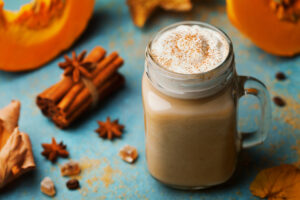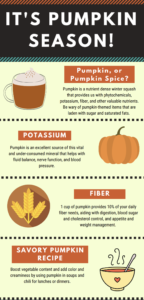
‘Tis the Season of Pumpkin Everything…but What is it Actually That You are Consuming?
Avril Rowerdink, RDN, LDN, CES
While all of my fall loving friends are happily embracing the weather shift, I would rather summer last forever. But one thing I am looking forward to is fall and winter vegetables, like pumpkin. There is something about the warmth and coziness of roasted fall and winter vegetables that makes me almost okay with giving up my short sleeves.
Pumpkin-themed food items are everywhere these days, and their arrival on the shelves seems to be happening earlier each year. Pumpkin Spice Season is a classic example of environmental factors influencing food choices. This classic fall flavor starts arriving in stores and food advertisements well before the season change, and in more and more items each year. The “seasonal” nature creates an artificial deadline and a scarcity mentality that can prompt us to justify our food choices without judgement. Sadly, but likely not surprisingly, these items not only lack the nutritional power of the winter squash, they are typically laden with added sugars and poor quality fats – a recipe for energy instability and fat storage.
Nutritional Value & Health Benefits of Pumpkin
Pumpkin is a starchy vegetable that is classified as a winter squash. It is nutrient dense and low in fat and calories. As with other orange-colored vegetables and fruits, pumpkin is high in beta-carotene – a phytonutrient and the precursor to the potent antioxidant vitamin A that supports immune function, healthy skin, and eye health. Phytonutrients are plant chemicals that support human health; reducing the risk of chronic disease (such as cancer, heart disease, diabetes, high blood pressure, and obesity) by reducing oxidative damage.
Just 1 cup of mashed pumpkin provides about 10% of your minimum daily fiber needs. I often describe fiber as a super nutrient because of all of its remarkable health benefits. Average daily fiber intake for Americans is ~15 grams – far under the 21-25 grams and 30-38 grams for women and men respectively, recommended by the Dietary Guidelines for Americans. Adequate fiber intake promotes optimal digestive health, weight management, and appetite regulation, helps prevent certain cancers and gastrointestinal diseases such as diverticulosis, and supports a diverse balance of gut bacteria which can positively impact health and metabolism in a variety of ways. Did you know that fiber can help control both blood sugar and blood cholesterol?
Pumpkin is a great source of potassium (~20% of daily needs in 1 cup!), a vital mineral that is widely used in the body. The Dietary Guidelines for Americans identifies potassium as a “nutrient of public health concern” because Americans struggle to get enough of it, while consuming an unproportionate amount of sodium. Potassium is required for normal cell function, helps with fluid balance, helps maintain healthy nerve function, plays a role in regulating heart rhythm, and may help lower the risk of osteoporosis and kidney stones. Higher potassium intake helps the body eliminate sodium, which helps to decrease blood pressure thereby reducing risk for heart disease and stroke – the 1st and 5th leading causes of death in the U.S.
Healthy Ways to Incorporate Pumpkin into Your Day
Bypass the shelves of pumpkin spice-flavored items on display at the grocery store (I am sorry Trader Joe’s, I do love you!) and consider incorporating real pumpkin into your dishes. One of my favorite savory ways to enjoy pumpkin is Turkey White Bean Pumpkin Chili from skinnytaste.com. I top it with a spoonful of nonfat Greek yogurt and a couple of tablespoons of diced avocado for some healthy fat. For a sweet treat, try these Oatmeal Pumpkin Chocolate Chip muffins for breakfast or snack – they’re great for hiking and camping too, and they freeze well! And here’s my hack for a pumpkin spice latte craving: order a coffee with 1 pump of pumpkin sauce and a splash of cream – you save yourself 320 calories, 40 (!) grams of sugar, and 7 grams of cholesterol-raising saturated fat, when comparing the medium size. ☺ Or better yet, try this recipe that incorporates real pumpkin: click here.
Happy Fall y’all! (I regretfully type as I await the return of summer…)

If you enjoyed and benefited from this information, please like and share it.
Yours in health and wellness,
Avril Rowerdink, RDN, LDN, CES
Our Dietitians/Nutritionists are here to help you and our office is open. Most major health insurance companies are now covering telehealth visits, usually at no cost to you. Our office will verify your benefits for you – both for existing patients and new patients. What you choose to eat is an essential part of managing your health and wellness. Let us help you to get on track and find a suitable individualized approach to help you to stay healthy.
Click here to contact us for more information.
Call Us Today: 919-990-1130





